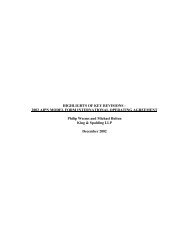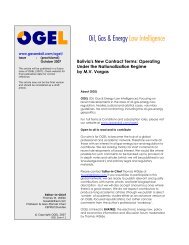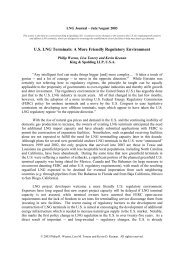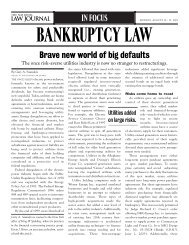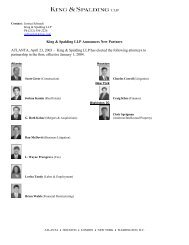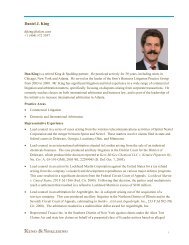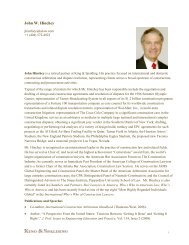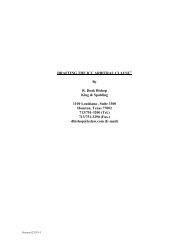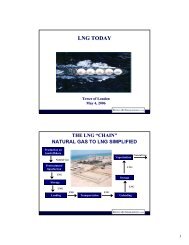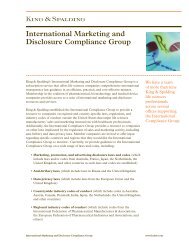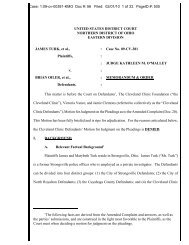Due Diligence Review: M&A Behind the Scenes - King & Spalding
Due Diligence Review: M&A Behind the Scenes - King & Spalding
Due Diligence Review: M&A Behind the Scenes - King & Spalding
Create successful ePaper yourself
Turn your PDF publications into a flip-book with our unique Google optimized e-Paper software.
INSURANCEduediligence<br />
Insurance <strong>Due</strong> <strong>Diligence</strong>:<br />
The Risk Web<br />
BY SIMON DODSWORTH<br />
One of <strong>the</strong> increasingly well known and respected disciplines<br />
in <strong>the</strong> acquirer’s toolkit is insurance due diligence.<br />
Where previous transactions have fallen foul of<br />
major hidden exposures, vendors and purchasers alike are ever<br />
more sensitive to <strong>the</strong> potential black holes that may develop<br />
where inadequate (or even non-existent) insurance is unear<strong>the</strong>d<br />
after completion of <strong>the</strong> transaction.<br />
So, <strong>the</strong> ultimate purpose of risk and insurance due diligence is<br />
to identify any potential deal-breakers including <strong>the</strong> significant<br />
cost implications for <strong>the</strong> deal structure. In turn this should assist<br />
<strong>the</strong> purchaser to:<br />
• Identify any hidden or underinsured liabilities or exposures<br />
which should / could be addressed by insurance<br />
• Minimise <strong>the</strong> parties reliance on contractual warranties<br />
• Provide comfort to <strong>the</strong> finance providers<br />
• Identify pre-emptive risk management measures that could<br />
ease future negotiations and preserve deal value<br />
However, as with all insurance due diligence, a key objective is<br />
not only to identify gaps in protection provided by insurance, but<br />
to develop solutions to fit such gaps. Like an iceberg, insurance<br />
due diligence is more about what you can’t see, ra<strong>the</strong>r than what<br />
you can. It is <strong>the</strong>se hidden liabilities that create <strong>the</strong> headaches for<br />
purchasers who are now heavily reliant on such due diligence as<br />
a result of <strong>the</strong> increasing awareness of lenders to aggregations of<br />
exposure in certain types of loss.<br />
Take for example, asbestos claims. It is well documented that<br />
<strong>the</strong> UK insurance industry is having difficulty digesting <strong>the</strong><br />
United States’ exposure to asbestos claims, an exposure which is<br />
also very much in evidence throughout Europe. The exposure to<br />
claims for potential lenders has led to <strong>the</strong> demand for a full analysis<br />
of loss activity where <strong>the</strong> potential exists for a material aggregation<br />
of asbestos claims.<br />
Compounding <strong>the</strong> issue in <strong>the</strong> UK is <strong>the</strong> insolvency of certain<br />
historical insurers impacting on <strong>the</strong> Financial Services<br />
Compensation Scheme (previously <strong>the</strong> Policyholders Protection<br />
20 FW <strong>Due</strong> <strong>Diligence</strong> <strong>Review</strong>: M&A <strong>Behind</strong> <strong>the</strong> <strong>Scenes</strong> 2004 | www.financierworldwide.com<br />
Board) and a business model called into question as a result of<br />
events which occurred in <strong>the</strong> 1950s and 1960s. At this time,<br />
insurance protection for employees was not a compulsory<br />
requirement. As a result, insurance due diligence often discovers<br />
significant gaps in liability coverage for those periods for a variety<br />
of reasons which include:<br />
• Insurance coverage was not purchased, or existed with low<br />
limits<br />
• Insurers are not traceable for <strong>the</strong>se periods<br />
• Insurers providing <strong>the</strong> coverage at <strong>the</strong> time are now insolvent<br />
With <strong>the</strong> tail of liability estimated for at least ano<strong>the</strong>r twenty<br />
years this is a specific, and real, exposure to equity and debt<br />
providers alike.<br />
Whilst asbestos is a well known and reported concern of <strong>the</strong> manufacturing<br />
sector, <strong>the</strong> advancement of specialist insurance advisers<br />
has created <strong>the</strong> opportunity for new products to be developed to<br />
meet previously uninsurable risk. Historically, Intellectual<br />
Property (IP) has been a notoriously difficult area in which to conduct<br />
due diligence and define risk profile. In conjunction with <strong>the</strong><br />
legal profession, <strong>the</strong> insurance market is now actively examining<br />
<strong>the</strong> intangible assets of business. Just as in environmental insurance<br />
products, most enquiries are a direct result of due diligence<br />
work being undertaken during a change of ownership when scrutiny<br />
of <strong>the</strong> insurance arrangements takes place.<br />
But <strong>the</strong> most interesting insurance due diligence exercises (and<br />
yes <strong>the</strong>re are plenty of <strong>the</strong>m!) involve a potential hole in <strong>the</strong><br />
insurance arrangements that require a solution. Such solutions<br />
can provide <strong>the</strong> bidder with a significant commercial advantage<br />
when making <strong>the</strong> bid.<br />
Case Study<br />
The Iceberg: Business acquired via share purchase, with cursory<br />
due diligence undertaken by corporate management. Whilst<br />
insurance policies were reviewed, including a review of claims<br />
reported to insurers, no investigation was undertaken into <strong>the</strong>



